Positive Leadership: Employee Performance and Psychological Capital
VerifiedAdded on 2021/12/05
|12
|2918
|29
Essay
AI Summary
This essay delves into the crucial role of positive leadership in enhancing employee performance within a competitive business environment. It examines the positive correlation between leadership skills and employee motivation, highlighting how effective leadership fosters innovation and facilitates the achievement of organizational goals. The essay analyzes various leadership styles, including transactional leadership, and explores the significance of employee engagement, communication, and workplace dynamics. It draws on research to illustrate the impact of positive leadership on employee well-being and job satisfaction, emphasizing the importance of senior leadership in shaping organizational culture and employee commitment. Furthermore, the essay discusses the connection between leadership behavior and employee turnover, underscoring the need for leaders to address workplace issues and promote a positive work environment. The conclusion emphasizes the undeniable influence of positive leadership on employee performance and the importance of adopting practices that include effective employee engagement and open communication.
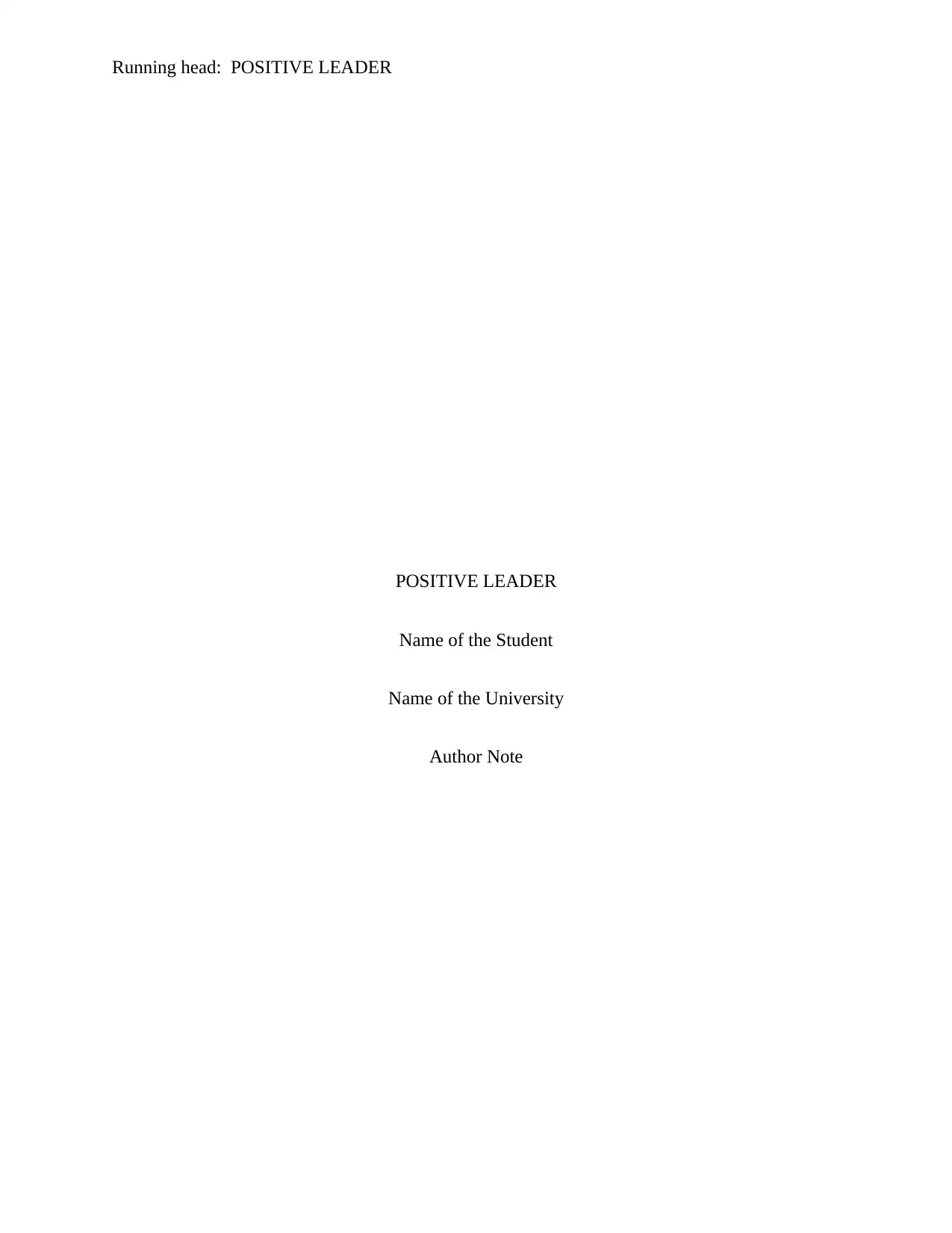
Running head: POSITIVE LEADER
POSITIVE LEADER
Name of the Student
Name of the University
Author Note
POSITIVE LEADER
Name of the Student
Name of the University
Author Note
Paraphrase This Document
Need a fresh take? Get an instant paraphrase of this document with our AI Paraphraser
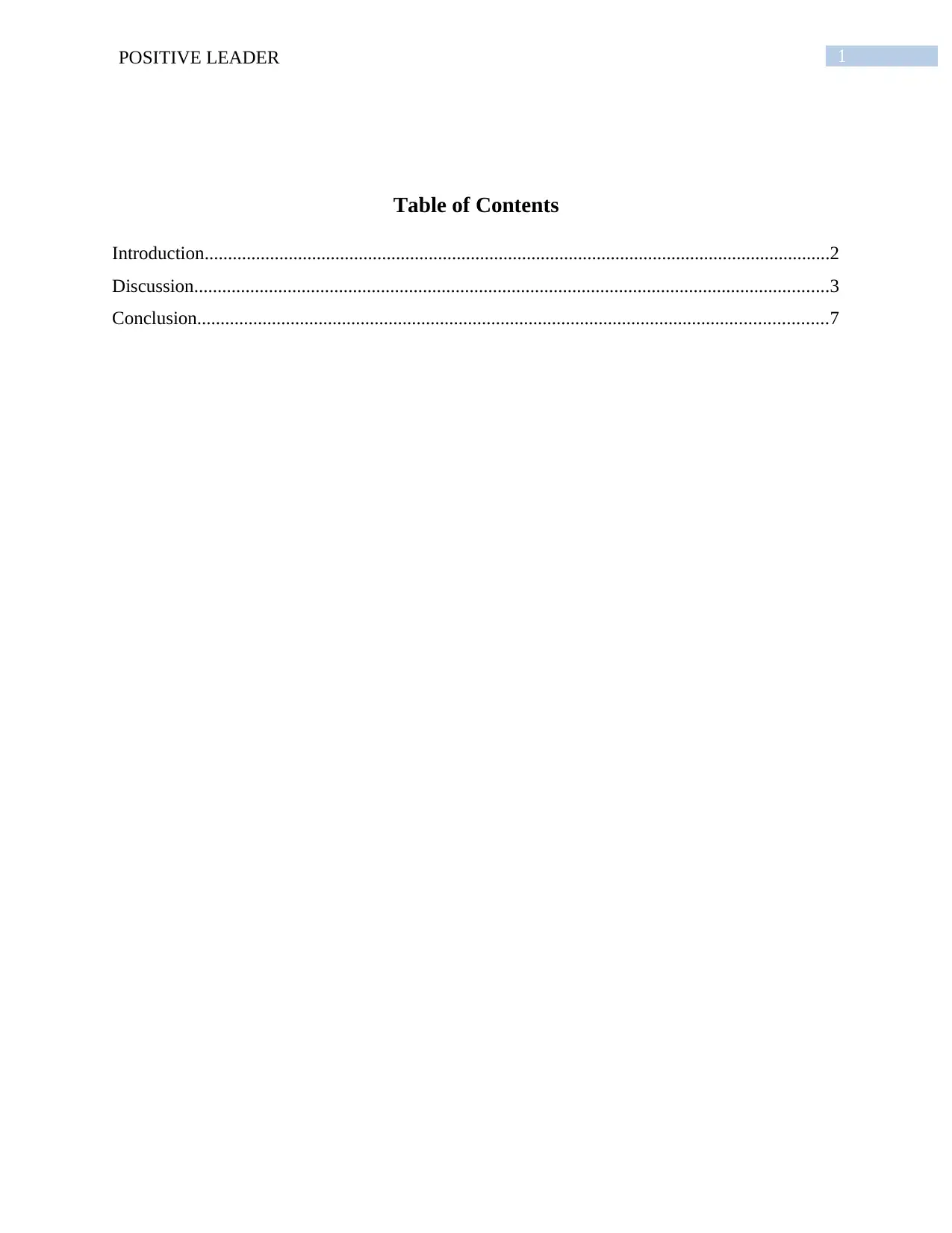
1POSITIVE LEADER
Table of Contents
Introduction......................................................................................................................................2
Discussion........................................................................................................................................3
Conclusion.......................................................................................................................................7
Table of Contents
Introduction......................................................................................................................................2
Discussion........................................................................................................................................3
Conclusion.......................................................................................................................................7
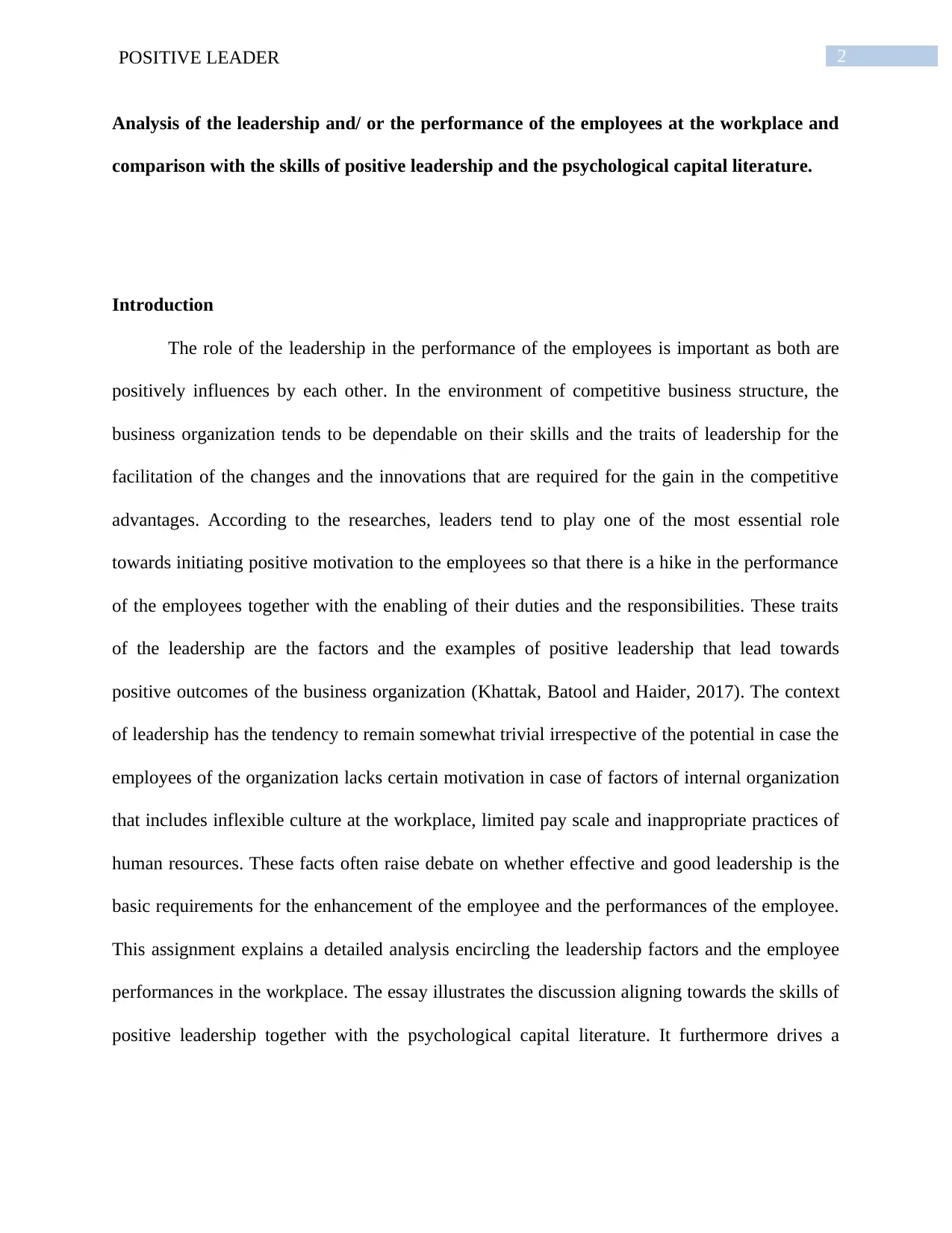
2POSITIVE LEADER
Analysis of the leadership and/ or the performance of the employees at the workplace and
comparison with the skills of positive leadership and the psychological capital literature.
Introduction
The role of the leadership in the performance of the employees is important as both are
positively influences by each other. In the environment of competitive business structure, the
business organization tends to be dependable on their skills and the traits of leadership for the
facilitation of the changes and the innovations that are required for the gain in the competitive
advantages. According to the researches, leaders tend to play one of the most essential role
towards initiating positive motivation to the employees so that there is a hike in the performance
of the employees together with the enabling of their duties and the responsibilities. These traits
of the leadership are the factors and the examples of positive leadership that lead towards
positive outcomes of the business organization (Khattak, Batool and Haider, 2017). The context
of leadership has the tendency to remain somewhat trivial irrespective of the potential in case the
employees of the organization lacks certain motivation in case of factors of internal organization
that includes inflexible culture at the workplace, limited pay scale and inappropriate practices of
human resources. These facts often raise debate on whether effective and good leadership is the
basic requirements for the enhancement of the employee and the performances of the employee.
This assignment explains a detailed analysis encircling the leadership factors and the employee
performances in the workplace. The essay illustrates the discussion aligning towards the skills of
positive leadership together with the psychological capital literature. It furthermore drives a
Analysis of the leadership and/ or the performance of the employees at the workplace and
comparison with the skills of positive leadership and the psychological capital literature.
Introduction
The role of the leadership in the performance of the employees is important as both are
positively influences by each other. In the environment of competitive business structure, the
business organization tends to be dependable on their skills and the traits of leadership for the
facilitation of the changes and the innovations that are required for the gain in the competitive
advantages. According to the researches, leaders tend to play one of the most essential role
towards initiating positive motivation to the employees so that there is a hike in the performance
of the employees together with the enabling of their duties and the responsibilities. These traits
of the leadership are the factors and the examples of positive leadership that lead towards
positive outcomes of the business organization (Khattak, Batool and Haider, 2017). The context
of leadership has the tendency to remain somewhat trivial irrespective of the potential in case the
employees of the organization lacks certain motivation in case of factors of internal organization
that includes inflexible culture at the workplace, limited pay scale and inappropriate practices of
human resources. These facts often raise debate on whether effective and good leadership is the
basic requirements for the enhancement of the employee and the performances of the employee.
This assignment explains a detailed analysis encircling the leadership factors and the employee
performances in the workplace. The essay illustrates the discussion aligning towards the skills of
positive leadership together with the psychological capital literature. It furthermore drives a
⊘ This is a preview!⊘
Do you want full access?
Subscribe today to unlock all pages.

Trusted by 1+ million students worldwide
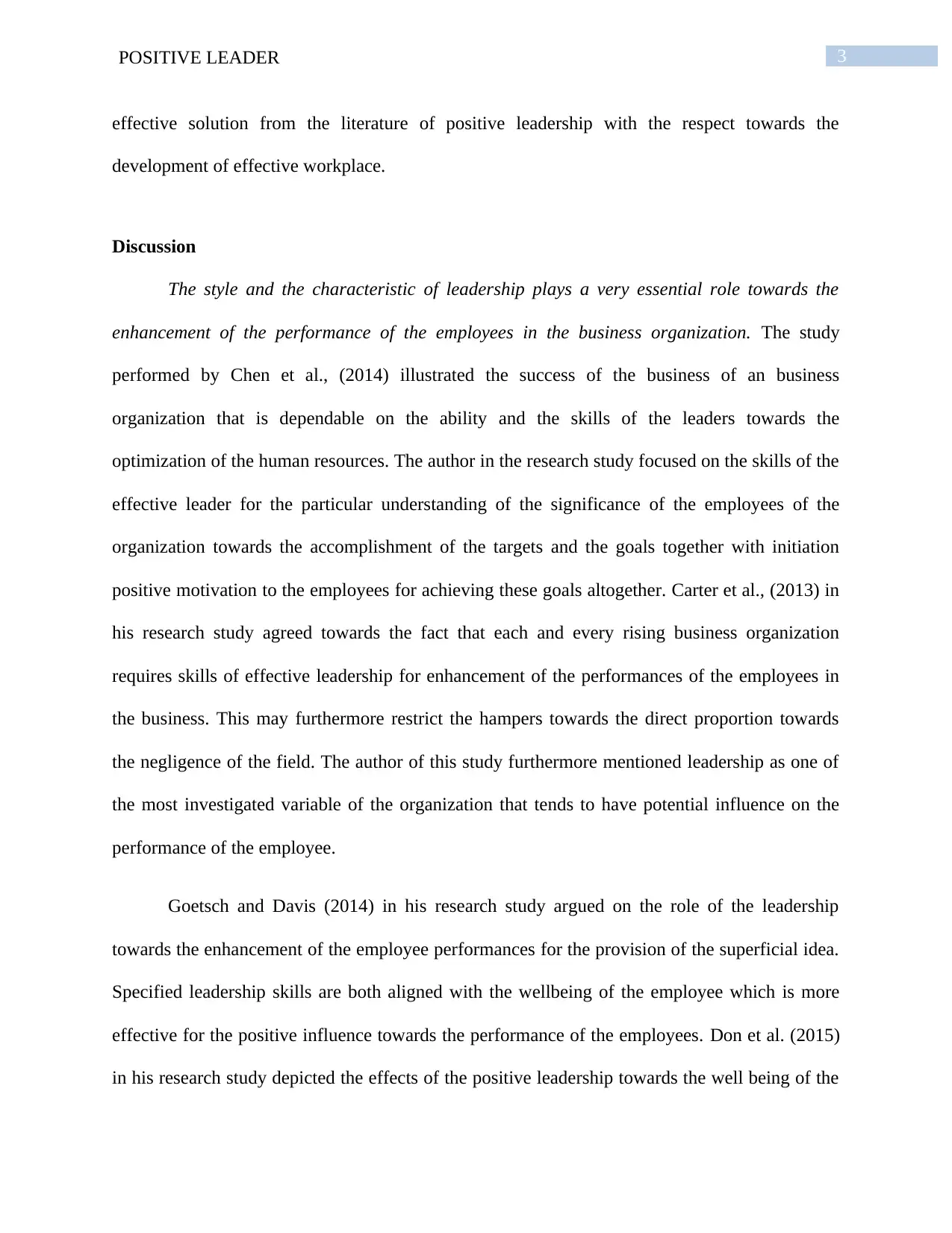
3POSITIVE LEADER
effective solution from the literature of positive leadership with the respect towards the
development of effective workplace.
Discussion
The style and the characteristic of leadership plays a very essential role towards the
enhancement of the performance of the employees in the business organization. The study
performed by Chen et al., (2014) illustrated the success of the business of an business
organization that is dependable on the ability and the skills of the leaders towards the
optimization of the human resources. The author in the research study focused on the skills of the
effective leader for the particular understanding of the significance of the employees of the
organization towards the accomplishment of the targets and the goals together with initiation
positive motivation to the employees for achieving these goals altogether. Carter et al., (2013) in
his research study agreed towards the fact that each and every rising business organization
requires skills of effective leadership for enhancement of the performances of the employees in
the business. This may furthermore restrict the hampers towards the direct proportion towards
the negligence of the field. The author of this study furthermore mentioned leadership as one of
the most investigated variable of the organization that tends to have potential influence on the
performance of the employee.
Goetsch and Davis (2014) in his research study argued on the role of the leadership
towards the enhancement of the employee performances for the provision of the superficial idea.
Specified leadership skills are both aligned with the wellbeing of the employee which is more
effective for the positive influence towards the performance of the employees. Don et al. (2015)
in his research study depicted the effects of the positive leadership towards the well being of the
effective solution from the literature of positive leadership with the respect towards the
development of effective workplace.
Discussion
The style and the characteristic of leadership plays a very essential role towards the
enhancement of the performance of the employees in the business organization. The study
performed by Chen et al., (2014) illustrated the success of the business of an business
organization that is dependable on the ability and the skills of the leaders towards the
optimization of the human resources. The author in the research study focused on the skills of the
effective leader for the particular understanding of the significance of the employees of the
organization towards the accomplishment of the targets and the goals together with initiation
positive motivation to the employees for achieving these goals altogether. Carter et al., (2013) in
his research study agreed towards the fact that each and every rising business organization
requires skills of effective leadership for enhancement of the performances of the employees in
the business. This may furthermore restrict the hampers towards the direct proportion towards
the negligence of the field. The author of this study furthermore mentioned leadership as one of
the most investigated variable of the organization that tends to have potential influence on the
performance of the employee.
Goetsch and Davis (2014) in his research study argued on the role of the leadership
towards the enhancement of the employee performances for the provision of the superficial idea.
Specified leadership skills are both aligned with the wellbeing of the employee which is more
effective for the positive influence towards the performance of the employees. Don et al. (2015)
in his research study depicted the effects of the positive leadership towards the well being of the
Paraphrase This Document
Need a fresh take? Get an instant paraphrase of this document with our AI Paraphraser
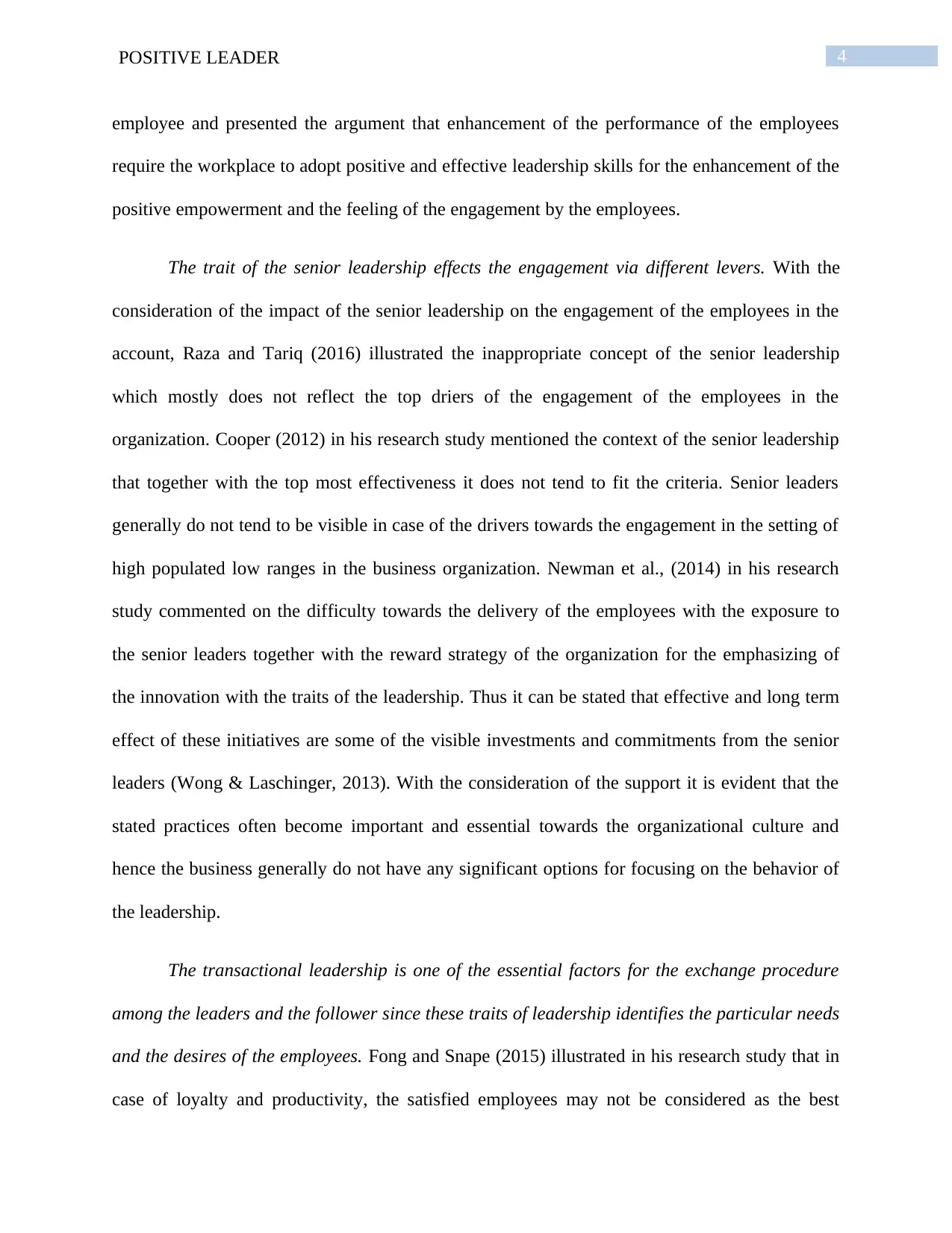
4POSITIVE LEADER
employee and presented the argument that enhancement of the performance of the employees
require the workplace to adopt positive and effective leadership skills for the enhancement of the
positive empowerment and the feeling of the engagement by the employees.
The trait of the senior leadership effects the engagement via different levers. With the
consideration of the impact of the senior leadership on the engagement of the employees in the
account, Raza and Tariq (2016) illustrated the inappropriate concept of the senior leadership
which mostly does not reflect the top driers of the engagement of the employees in the
organization. Cooper (2012) in his research study mentioned the context of the senior leadership
that together with the top most effectiveness it does not tend to fit the criteria. Senior leaders
generally do not tend to be visible in case of the drivers towards the engagement in the setting of
high populated low ranges in the business organization. Newman et al., (2014) in his research
study commented on the difficulty towards the delivery of the employees with the exposure to
the senior leaders together with the reward strategy of the organization for the emphasizing of
the innovation with the traits of the leadership. Thus it can be stated that effective and long term
effect of these initiatives are some of the visible investments and commitments from the senior
leaders (Wong & Laschinger, 2013). With the consideration of the support it is evident that the
stated practices often become important and essential towards the organizational culture and
hence the business generally do not have any significant options for focusing on the behavior of
the leadership.
The transactional leadership is one of the essential factors for the exchange procedure
among the leaders and the follower since these traits of leadership identifies the particular needs
and the desires of the employees. Fong and Snape (2015) illustrated in his research study that in
case of loyalty and productivity, the satisfied employees may not be considered as the best
employee and presented the argument that enhancement of the performance of the employees
require the workplace to adopt positive and effective leadership skills for the enhancement of the
positive empowerment and the feeling of the engagement by the employees.
The trait of the senior leadership effects the engagement via different levers. With the
consideration of the impact of the senior leadership on the engagement of the employees in the
account, Raza and Tariq (2016) illustrated the inappropriate concept of the senior leadership
which mostly does not reflect the top driers of the engagement of the employees in the
organization. Cooper (2012) in his research study mentioned the context of the senior leadership
that together with the top most effectiveness it does not tend to fit the criteria. Senior leaders
generally do not tend to be visible in case of the drivers towards the engagement in the setting of
high populated low ranges in the business organization. Newman et al., (2014) in his research
study commented on the difficulty towards the delivery of the employees with the exposure to
the senior leaders together with the reward strategy of the organization for the emphasizing of
the innovation with the traits of the leadership. Thus it can be stated that effective and long term
effect of these initiatives are some of the visible investments and commitments from the senior
leaders (Wong & Laschinger, 2013). With the consideration of the support it is evident that the
stated practices often become important and essential towards the organizational culture and
hence the business generally do not have any significant options for focusing on the behavior of
the leadership.
The transactional leadership is one of the essential factors for the exchange procedure
among the leaders and the follower since these traits of leadership identifies the particular needs
and the desires of the employees. Fong and Snape (2015) illustrated in his research study that in
case of loyalty and productivity, the satisfied employees may not be considered as the best
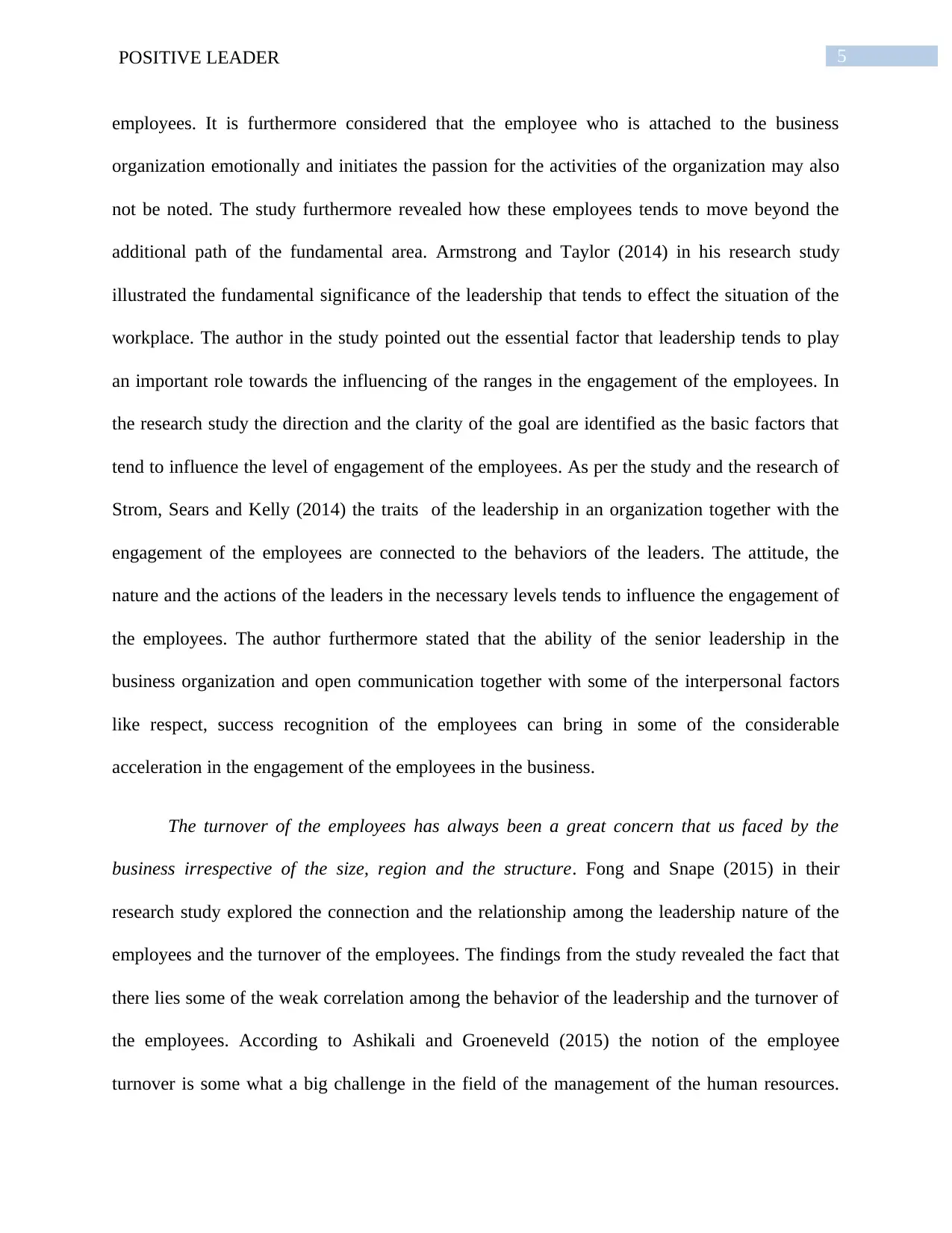
5POSITIVE LEADER
employees. It is furthermore considered that the employee who is attached to the business
organization emotionally and initiates the passion for the activities of the organization may also
not be noted. The study furthermore revealed how these employees tends to move beyond the
additional path of the fundamental area. Armstrong and Taylor (2014) in his research study
illustrated the fundamental significance of the leadership that tends to effect the situation of the
workplace. The author in the study pointed out the essential factor that leadership tends to play
an important role towards the influencing of the ranges in the engagement of the employees. In
the research study the direction and the clarity of the goal are identified as the basic factors that
tend to influence the level of engagement of the employees. As per the study and the research of
Strom, Sears and Kelly (2014) the traits of the leadership in an organization together with the
engagement of the employees are connected to the behaviors of the leaders. The attitude, the
nature and the actions of the leaders in the necessary levels tends to influence the engagement of
the employees. The author furthermore stated that the ability of the senior leadership in the
business organization and open communication together with some of the interpersonal factors
like respect, success recognition of the employees can bring in some of the considerable
acceleration in the engagement of the employees in the business.
The turnover of the employees has always been a great concern that us faced by the
business irrespective of the size, region and the structure. Fong and Snape (2015) in their
research study explored the connection and the relationship among the leadership nature of the
employees and the turnover of the employees. The findings from the study revealed the fact that
there lies some of the weak correlation among the behavior of the leadership and the turnover of
the employees. According to Ashikali and Groeneveld (2015) the notion of the employee
turnover is some what a big challenge in the field of the management of the human resources.
employees. It is furthermore considered that the employee who is attached to the business
organization emotionally and initiates the passion for the activities of the organization may also
not be noted. The study furthermore revealed how these employees tends to move beyond the
additional path of the fundamental area. Armstrong and Taylor (2014) in his research study
illustrated the fundamental significance of the leadership that tends to effect the situation of the
workplace. The author in the study pointed out the essential factor that leadership tends to play
an important role towards the influencing of the ranges in the engagement of the employees. In
the research study the direction and the clarity of the goal are identified as the basic factors that
tend to influence the level of engagement of the employees. As per the study and the research of
Strom, Sears and Kelly (2014) the traits of the leadership in an organization together with the
engagement of the employees are connected to the behaviors of the leaders. The attitude, the
nature and the actions of the leaders in the necessary levels tends to influence the engagement of
the employees. The author furthermore stated that the ability of the senior leadership in the
business organization and open communication together with some of the interpersonal factors
like respect, success recognition of the employees can bring in some of the considerable
acceleration in the engagement of the employees in the business.
The turnover of the employees has always been a great concern that us faced by the
business irrespective of the size, region and the structure. Fong and Snape (2015) in their
research study explored the connection and the relationship among the leadership nature of the
employees and the turnover of the employees. The findings from the study revealed the fact that
there lies some of the weak correlation among the behavior of the leadership and the turnover of
the employees. According to Ashikali and Groeneveld (2015) the notion of the employee
turnover is some what a big challenge in the field of the management of the human resources.
⊘ This is a preview!⊘
Do you want full access?
Subscribe today to unlock all pages.

Trusted by 1+ million students worldwide
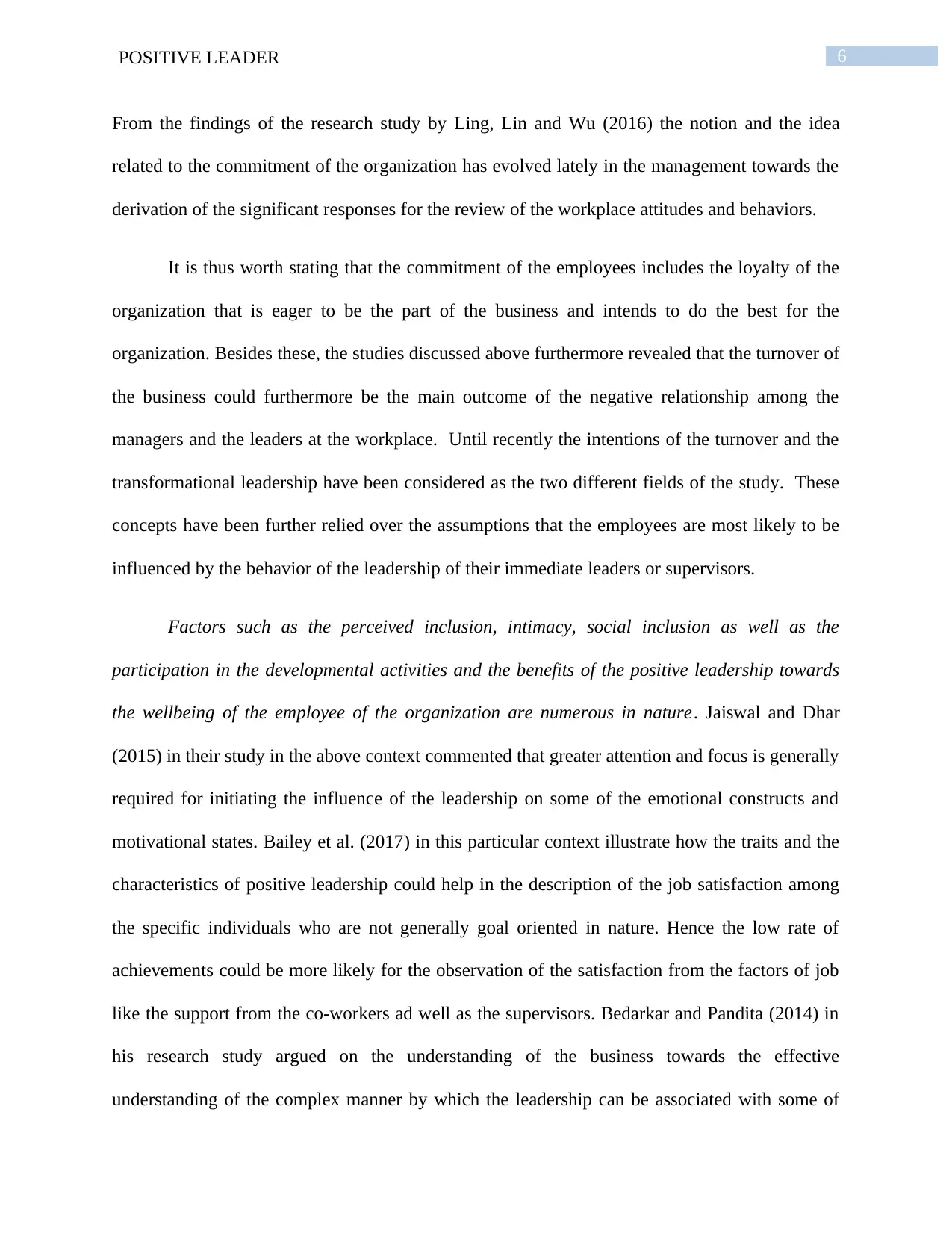
6POSITIVE LEADER
From the findings of the research study by Ling, Lin and Wu (2016) the notion and the idea
related to the commitment of the organization has evolved lately in the management towards the
derivation of the significant responses for the review of the workplace attitudes and behaviors.
It is thus worth stating that the commitment of the employees includes the loyalty of the
organization that is eager to be the part of the business and intends to do the best for the
organization. Besides these, the studies discussed above furthermore revealed that the turnover of
the business could furthermore be the main outcome of the negative relationship among the
managers and the leaders at the workplace. Until recently the intentions of the turnover and the
transformational leadership have been considered as the two different fields of the study. These
concepts have been further relied over the assumptions that the employees are most likely to be
influenced by the behavior of the leadership of their immediate leaders or supervisors.
Factors such as the perceived inclusion, intimacy, social inclusion as well as the
participation in the developmental activities and the benefits of the positive leadership towards
the wellbeing of the employee of the organization are numerous in nature. Jaiswal and Dhar
(2015) in their study in the above context commented that greater attention and focus is generally
required for initiating the influence of the leadership on some of the emotional constructs and
motivational states. Bailey et al. (2017) in this particular context illustrate how the traits and the
characteristics of positive leadership could help in the description of the job satisfaction among
the specific individuals who are not generally goal oriented in nature. Hence the low rate of
achievements could be more likely for the observation of the satisfaction from the factors of job
like the support from the co-workers ad well as the supervisors. Bedarkar and Pandita (2014) in
his research study argued on the understanding of the business towards the effective
understanding of the complex manner by which the leadership can be associated with some of
From the findings of the research study by Ling, Lin and Wu (2016) the notion and the idea
related to the commitment of the organization has evolved lately in the management towards the
derivation of the significant responses for the review of the workplace attitudes and behaviors.
It is thus worth stating that the commitment of the employees includes the loyalty of the
organization that is eager to be the part of the business and intends to do the best for the
organization. Besides these, the studies discussed above furthermore revealed that the turnover of
the business could furthermore be the main outcome of the negative relationship among the
managers and the leaders at the workplace. Until recently the intentions of the turnover and the
transformational leadership have been considered as the two different fields of the study. These
concepts have been further relied over the assumptions that the employees are most likely to be
influenced by the behavior of the leadership of their immediate leaders or supervisors.
Factors such as the perceived inclusion, intimacy, social inclusion as well as the
participation in the developmental activities and the benefits of the positive leadership towards
the wellbeing of the employee of the organization are numerous in nature. Jaiswal and Dhar
(2015) in their study in the above context commented that greater attention and focus is generally
required for initiating the influence of the leadership on some of the emotional constructs and
motivational states. Bailey et al. (2017) in this particular context illustrate how the traits and the
characteristics of positive leadership could help in the description of the job satisfaction among
the specific individuals who are not generally goal oriented in nature. Hence the low rate of
achievements could be more likely for the observation of the satisfaction from the factors of job
like the support from the co-workers ad well as the supervisors. Bedarkar and Pandita (2014) in
his research study argued on the understanding of the business towards the effective
understanding of the complex manner by which the leadership can be associated with some of
Paraphrase This Document
Need a fresh take? Get an instant paraphrase of this document with our AI Paraphraser
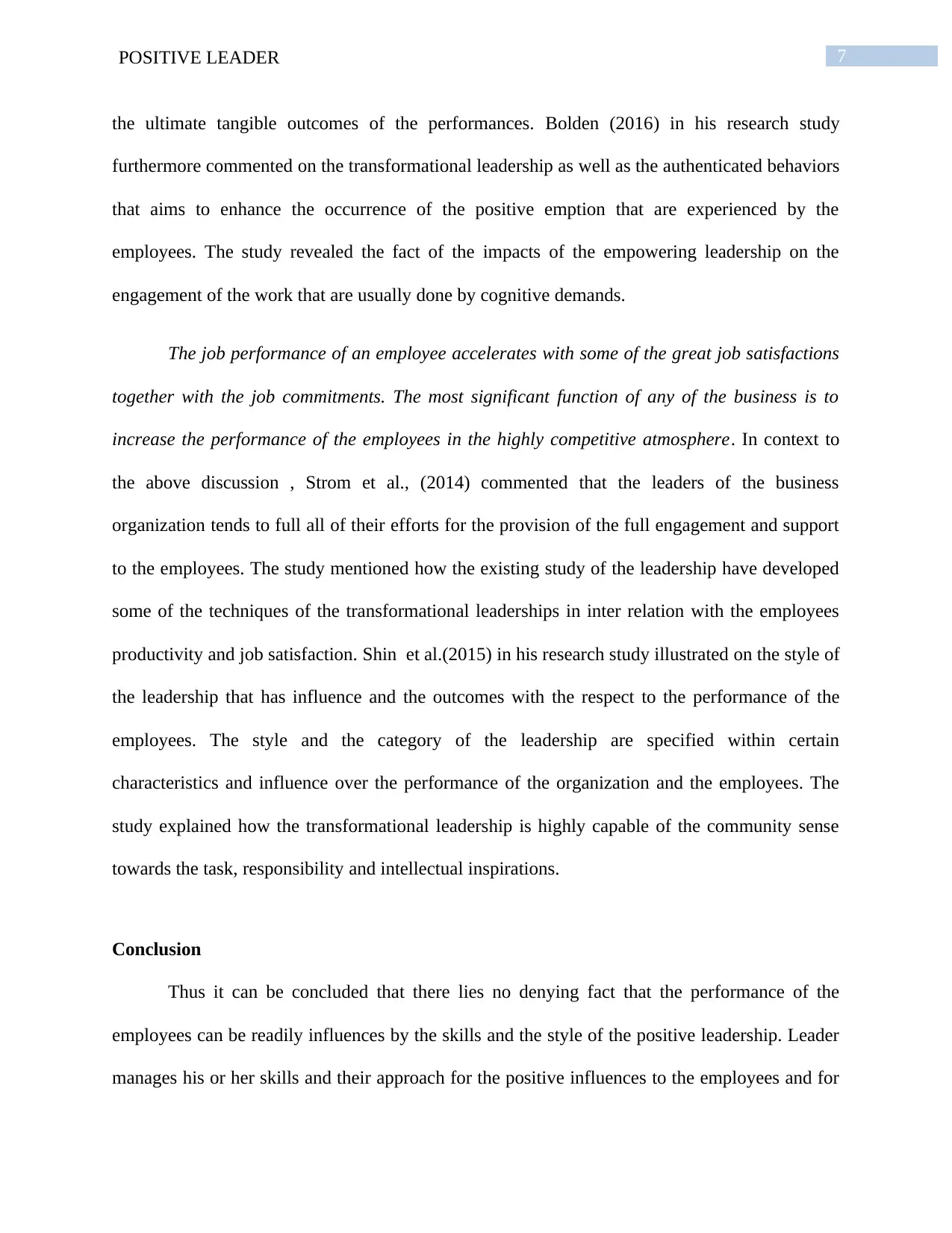
7POSITIVE LEADER
the ultimate tangible outcomes of the performances. Bolden (2016) in his research study
furthermore commented on the transformational leadership as well as the authenticated behaviors
that aims to enhance the occurrence of the positive emption that are experienced by the
employees. The study revealed the fact of the impacts of the empowering leadership on the
engagement of the work that are usually done by cognitive demands.
The job performance of an employee accelerates with some of the great job satisfactions
together with the job commitments. The most significant function of any of the business is to
increase the performance of the employees in the highly competitive atmosphere. In context to
the above discussion , Strom et al., (2014) commented that the leaders of the business
organization tends to full all of their efforts for the provision of the full engagement and support
to the employees. The study mentioned how the existing study of the leadership have developed
some of the techniques of the transformational leaderships in inter relation with the employees
productivity and job satisfaction. Shin et al.(2015) in his research study illustrated on the style of
the leadership that has influence and the outcomes with the respect to the performance of the
employees. The style and the category of the leadership are specified within certain
characteristics and influence over the performance of the organization and the employees. The
study explained how the transformational leadership is highly capable of the community sense
towards the task, responsibility and intellectual inspirations.
Conclusion
Thus it can be concluded that there lies no denying fact that the performance of the
employees can be readily influences by the skills and the style of the positive leadership. Leader
manages his or her skills and their approach for the positive influences to the employees and for
the ultimate tangible outcomes of the performances. Bolden (2016) in his research study
furthermore commented on the transformational leadership as well as the authenticated behaviors
that aims to enhance the occurrence of the positive emption that are experienced by the
employees. The study revealed the fact of the impacts of the empowering leadership on the
engagement of the work that are usually done by cognitive demands.
The job performance of an employee accelerates with some of the great job satisfactions
together with the job commitments. The most significant function of any of the business is to
increase the performance of the employees in the highly competitive atmosphere. In context to
the above discussion , Strom et al., (2014) commented that the leaders of the business
organization tends to full all of their efforts for the provision of the full engagement and support
to the employees. The study mentioned how the existing study of the leadership have developed
some of the techniques of the transformational leaderships in inter relation with the employees
productivity and job satisfaction. Shin et al.(2015) in his research study illustrated on the style of
the leadership that has influence and the outcomes with the respect to the performance of the
employees. The style and the category of the leadership are specified within certain
characteristics and influence over the performance of the organization and the employees. The
study explained how the transformational leadership is highly capable of the community sense
towards the task, responsibility and intellectual inspirations.
Conclusion
Thus it can be concluded that there lies no denying fact that the performance of the
employees can be readily influences by the skills and the style of the positive leadership. Leader
manages his or her skills and their approach for the positive influences to the employees and for

8POSITIVE LEADER
the performance of effective roles and responsibilities accordingly. There furthermore lies some
of the evident practices that the style of the leadership should consider. These includes effective
employee engagement, establishment of suitable healthy and open communication and
management of the workplace issues of the employees. The context of leadership has the
tendency to remain somewhat trivial irrespective of the potential in case the employees of the
organization lacks certain motivation in case of factors of internal organization that includes
inflexible culture at the workplace, limited pay scale and inappropriate practices of human
resources. It is thus important to note the positive connection among the communication and
employee performances by the leaders in the business organization.
the performance of effective roles and responsibilities accordingly. There furthermore lies some
of the evident practices that the style of the leadership should consider. These includes effective
employee engagement, establishment of suitable healthy and open communication and
management of the workplace issues of the employees. The context of leadership has the
tendency to remain somewhat trivial irrespective of the potential in case the employees of the
organization lacks certain motivation in case of factors of internal organization that includes
inflexible culture at the workplace, limited pay scale and inappropriate practices of human
resources. It is thus important to note the positive connection among the communication and
employee performances by the leaders in the business organization.
⊘ This is a preview!⊘
Do you want full access?
Subscribe today to unlock all pages.

Trusted by 1+ million students worldwide

9POSITIVE LEADER
References
Armstrong, M. and Taylor, S., 2014. Armstrong's handbook of human resource management
practice. Kogan Page Publishers.
Ashikali, T. and Groeneveld, S., 2015. Diversity management in public organizations and its
effect on employees’ affective commitment: The role of transformational leadership and
the inclusiveness of the organizational culture. Review of Public Personnel
Administration, 35(2), pp.146-168.
Bailey, C., Madden, A., Alfes, K. and Fletcher, L., 2017. The meaning, antecedents and
outcomes of employee engagement: A narrative synthesis. International Journal of
Management Reviews, 19(1), pp.31-53.
Bedarkar, M., &Pandita, D. (2014). A study on the drivers of employee engagement impacting
employee performance. Procedia-Social and Behavioral Sciences, 133, 106-115.
Bolden, R., 2016. Leadership, management and organisational development. In Gower handbook
of leadership and management development (pp. 143-158). Routledge.
Carter, M. Z., Armenakis, A. A., Feild, H. S., &Mossholder, K. W. (2013). Transformational
leadership, relationship quality, and employee performance during continuous
incremental organizational change. Journal of Organizational Behavior, 34(7), 942-958.
Chen, X. P., Eberly, M. B., Chiang, T. J., Farh, J. L., & Cheng, B. S. (2014). Affective trust in
Chinese leaders: Linking paternalistic leadership to employee performance. Journal of
management, 40(3), 796-819.
References
Armstrong, M. and Taylor, S., 2014. Armstrong's handbook of human resource management
practice. Kogan Page Publishers.
Ashikali, T. and Groeneveld, S., 2015. Diversity management in public organizations and its
effect on employees’ affective commitment: The role of transformational leadership and
the inclusiveness of the organizational culture. Review of Public Personnel
Administration, 35(2), pp.146-168.
Bailey, C., Madden, A., Alfes, K. and Fletcher, L., 2017. The meaning, antecedents and
outcomes of employee engagement: A narrative synthesis. International Journal of
Management Reviews, 19(1), pp.31-53.
Bedarkar, M., &Pandita, D. (2014). A study on the drivers of employee engagement impacting
employee performance. Procedia-Social and Behavioral Sciences, 133, 106-115.
Bolden, R., 2016. Leadership, management and organisational development. In Gower handbook
of leadership and management development (pp. 143-158). Routledge.
Carter, M. Z., Armenakis, A. A., Feild, H. S., &Mossholder, K. W. (2013). Transformational
leadership, relationship quality, and employee performance during continuous
incremental organizational change. Journal of Organizational Behavior, 34(7), 942-958.
Chen, X. P., Eberly, M. B., Chiang, T. J., Farh, J. L., & Cheng, B. S. (2014). Affective trust in
Chinese leaders: Linking paternalistic leadership to employee performance. Journal of
management, 40(3), 796-819.
Paraphrase This Document
Need a fresh take? Get an instant paraphrase of this document with our AI Paraphraser
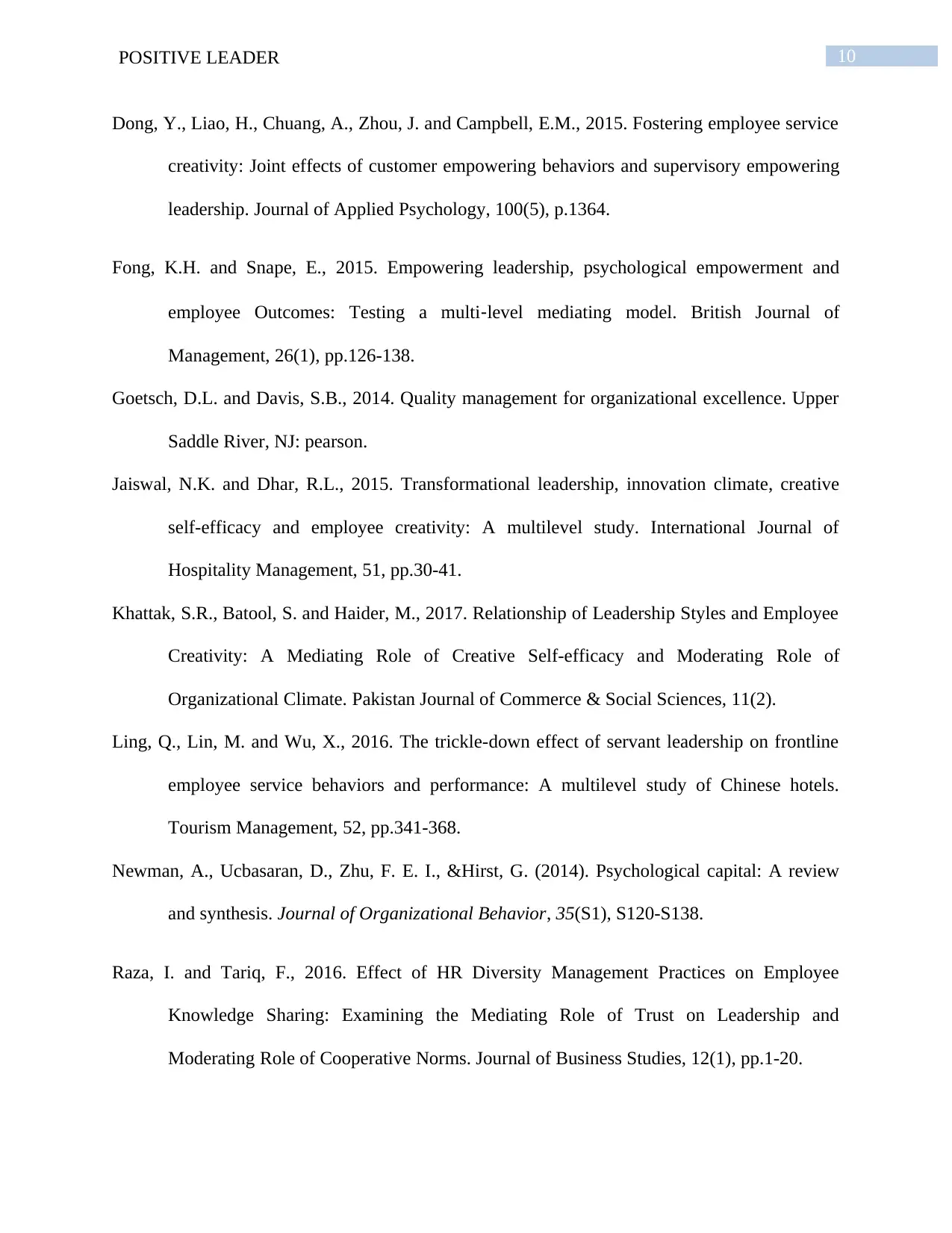
10POSITIVE LEADER
Dong, Y., Liao, H., Chuang, A., Zhou, J. and Campbell, E.M., 2015. Fostering employee service
creativity: Joint effects of customer empowering behaviors and supervisory empowering
leadership. Journal of Applied Psychology, 100(5), p.1364.
Fong, K.H. and Snape, E., 2015. Empowering leadership, psychological empowerment and
employee Outcomes: Testing a multi‐level mediating model. British Journal of
Management, 26(1), pp.126-138.
Goetsch, D.L. and Davis, S.B., 2014. Quality management for organizational excellence. Upper
Saddle River, NJ: pearson.
Jaiswal, N.K. and Dhar, R.L., 2015. Transformational leadership, innovation climate, creative
self-efficacy and employee creativity: A multilevel study. International Journal of
Hospitality Management, 51, pp.30-41.
Khattak, S.R., Batool, S. and Haider, M., 2017. Relationship of Leadership Styles and Employee
Creativity: A Mediating Role of Creative Self-efficacy and Moderating Role of
Organizational Climate. Pakistan Journal of Commerce & Social Sciences, 11(2).
Ling, Q., Lin, M. and Wu, X., 2016. The trickle-down effect of servant leadership on frontline
employee service behaviors and performance: A multilevel study of Chinese hotels.
Tourism Management, 52, pp.341-368.
Newman, A., Ucbasaran, D., Zhu, F. E. I., &Hirst, G. (2014). Psychological capital: A review
and synthesis. Journal of Organizational Behavior, 35(S1), S120-S138.
Raza, I. and Tariq, F., 2016. Effect of HR Diversity Management Practices on Employee
Knowledge Sharing: Examining the Mediating Role of Trust on Leadership and
Moderating Role of Cooperative Norms. Journal of Business Studies, 12(1), pp.1-20.
Dong, Y., Liao, H., Chuang, A., Zhou, J. and Campbell, E.M., 2015. Fostering employee service
creativity: Joint effects of customer empowering behaviors and supervisory empowering
leadership. Journal of Applied Psychology, 100(5), p.1364.
Fong, K.H. and Snape, E., 2015. Empowering leadership, psychological empowerment and
employee Outcomes: Testing a multi‐level mediating model. British Journal of
Management, 26(1), pp.126-138.
Goetsch, D.L. and Davis, S.B., 2014. Quality management for organizational excellence. Upper
Saddle River, NJ: pearson.
Jaiswal, N.K. and Dhar, R.L., 2015. Transformational leadership, innovation climate, creative
self-efficacy and employee creativity: A multilevel study. International Journal of
Hospitality Management, 51, pp.30-41.
Khattak, S.R., Batool, S. and Haider, M., 2017. Relationship of Leadership Styles and Employee
Creativity: A Mediating Role of Creative Self-efficacy and Moderating Role of
Organizational Climate. Pakistan Journal of Commerce & Social Sciences, 11(2).
Ling, Q., Lin, M. and Wu, X., 2016. The trickle-down effect of servant leadership on frontline
employee service behaviors and performance: A multilevel study of Chinese hotels.
Tourism Management, 52, pp.341-368.
Newman, A., Ucbasaran, D., Zhu, F. E. I., &Hirst, G. (2014). Psychological capital: A review
and synthesis. Journal of Organizational Behavior, 35(S1), S120-S138.
Raza, I. and Tariq, F., 2016. Effect of HR Diversity Management Practices on Employee
Knowledge Sharing: Examining the Mediating Role of Trust on Leadership and
Moderating Role of Cooperative Norms. Journal of Business Studies, 12(1), pp.1-20.

11POSITIVE LEADER
Shin, Y., Sung, S.Y., Choi, J.N. and Kim, M.S., 2015. Top management ethical leadership and
firm performance: Mediating role of ethical and procedural justice climate. Journal of
Business Ethics, 129(1), pp.43-57.
Strom, D. L., Sears, K. L., & Kelly, K. M. (2014). Work engagement: The roles of organizational
justice and leadership style in predicting engagement among employees. Journal of
Leadership & Organizational Studies, 21(1), 71-82.
Wong, C. A., &Laschinger, H. K. (2013). Authentic leadership, performance, and job
satisfaction: the mediating role of empowerment. Journal of advanced nursing, 69(4),
947-959.
Shin, Y., Sung, S.Y., Choi, J.N. and Kim, M.S., 2015. Top management ethical leadership and
firm performance: Mediating role of ethical and procedural justice climate. Journal of
Business Ethics, 129(1), pp.43-57.
Strom, D. L., Sears, K. L., & Kelly, K. M. (2014). Work engagement: The roles of organizational
justice and leadership style in predicting engagement among employees. Journal of
Leadership & Organizational Studies, 21(1), 71-82.
Wong, C. A., &Laschinger, H. K. (2013). Authentic leadership, performance, and job
satisfaction: the mediating role of empowerment. Journal of advanced nursing, 69(4),
947-959.
⊘ This is a preview!⊘
Do you want full access?
Subscribe today to unlock all pages.

Trusted by 1+ million students worldwide
1 out of 12
Related Documents
Your All-in-One AI-Powered Toolkit for Academic Success.
+13062052269
info@desklib.com
Available 24*7 on WhatsApp / Email
![[object Object]](/_next/static/media/star-bottom.7253800d.svg)
Unlock your academic potential
Copyright © 2020–2025 A2Z Services. All Rights Reserved. Developed and managed by ZUCOL.





